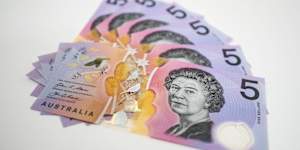Since 1923,the reigning monarch has featured on the nation’s notes with Queen Elizabeth on the $5 note since 1992.
But the Reserve Bank,which controls the nation’s cash,revealed on Thursday that a design honouring the culture and history of the First Australians would replace the Queen rather than her son.

Australia’s $5 note.Supplied
The RBA said it consulted the federal government before making its decision,and had the government’s support.
“The bank will consult First Australians in designing the $5 banknote. The new banknote will take a number of years to be designed and printed,” the Reserve Bank said in a statement.
King Charles III will not appear on the new $5 note with a design honouring First Australians to be used instead.
Treasurer Jim Chalmers said the government supported the Reserve Bank’s decision,saying while the monarchy would disappear from the nation’s notes,King Charles would remain on the nation’s coins.
“I think this is a good opportunity to strike a good balance between the monarch on the coins and the First Nations design on the fiver,” he said.
“But the $5 note will say more about our history and our heritage,our country and I see that as a good thing.”
It’s understood the RBA board,whose members were all appointed by former Liberal treasurers Scott Morrison and Josh Frydenberg,agreed to the change before the decision was raised with Chalmers.
But Opposition leader Peter Dutton accused the government of leading the change,labelling it “another attack on our systems,on our society and our institutions” in an interview with Ray Hadley on 2GB radio this morning.
Dutton said the federal government should “own up” to its role in settling on the new design.
“There’s no question about this. It’s directed by the government ... He[Prime Minister Anthony Albanese] would have been central to the decision-making,” he said.
Dutton said there had been “significant attacks” on Australia Day and warned of pending attacks on “the national anthem,the flag and the name of Australia”.
He also said the “silent majority” of Australians don’t agree with the “woke nonsense”.
Liberal senator and monarchist Dean Smith said he was disappointed at the decision,describing it as a missed opportunity.
“Although not totally unexpected,breaking with this long tradition will come as a disappointment to many Australians,who have never known anything different,” he said.
“A design incorporating both our new King and an appreciation for Australia’s Indigenous heritage and culture would be a better and more unifying approach.
“This decision misses a unique opportunity for both the RBA and Anthony Albanese to merge these two important aspects of Australia’s story.”
National chair of the Australian Monarchist League,Philip Benwell,accused the government of being “neo-communist” with the move.
“It is virtually neo-communism in action. President Xi could possibly learn a few tricks from our prime minister. It is certainly not Australian democracy and it is certainly not what the people voted for in May 2022,” he said.
The Reserve Bank said the current $5 note,of which there are about 208 million in circulation,will continue to be issued until a new design can be printed,and the current banknotes will be usable even after new ones are produced.
The Australian Parliament House would continue to feature on the other side of the note.
The monarch has featured on an Australian note since 1923 when a portrait of King George V was added to every denomination. It was also the year Indigenous Australians were first featured on the notes,albeit in the background of a painting of Captain James Cook’s landing at Port Jackson.
The first prominent display of Indigenous Australians occurred when decimal currency was introduced in 1966.
The first $1 dollar note,designed by Gordon Andrews,displayed imagery of Indigenous rock paintings and carvings. On the left-hand side of the note,images from a bark painting by artist David Malangi Daymirringu were also used.
After the $1 note was taken out of circulation,it was not until 1988 that a commemorative $10 polymer note again prominently featured Indigenous culture.
With David Crowe,Caroline Schelle and Greg Dundas
Cut through the noise of federal politics with news,views and expert analysis from Jacqueline Maley..